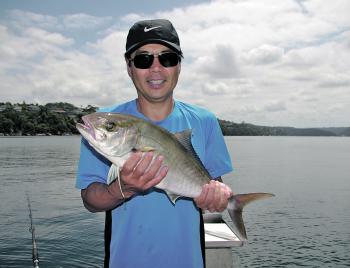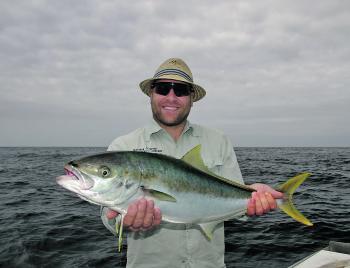This season has been on fire for mulloway. In fact, it’s been the best I’ve seen in 10 years. They are being taken throughout Middle Harbour and the mid reaches of the harbour. The mulloway are following the early mullet and tailor run, so obviously, mullet and tailor are a good choice of bait. Big live squid and strips of squid are also great baits.
Don’t discount shallow water at night either, especially if there are high concentrations of mullet, such as you might find at the weir at Lane Cove River, or creek junctions like the ones above Roseville bridge. Blues and Balls Heads in the harbour and Seaforth Bluff, Killarney Point and Pickering Point in Middle Harbour are great places to sit with live baits or a big slab of fresh squid on the turn of the high tide.
The very warm water off Sydney this season has attracted some tropical ring-ins including the best cobia run in many years. Your chances of catching one are slim, but might be improved if you target them specifically. They are generally caught between February and May. Most captures have coincided with a large influx of sharks into the harbour, and captures of remora in the same area. The cobia I cleaned recently had three stingrays in its gut, which is a fair indication that cobias feed on or near the bottom. Discussions with LGB boys revealed that the best locations are rock platforms that fall onto a sand bottom. We have taken our biggest ones in Middle Harbour around Bantry Bay. The best baits include sand crabs, yakkas, squid and slimies. The best spots in the harbour include Cannae Point, North Head, Middle Head, Middle Harbour and Clifton Gardens. Cobia are the most delicious pelagics I have ever eaten, with flesh that tastes more like a reef fish than a game fish. This most likely is due to their diet.
Samsonfish are much more common, but their numbers fluctuate. Our best year produced over 50 and our worst only two. Generally, they appear to be coming more common. They can come in as early as December but are most prolific around Easter. You will also find that the years when amberjack are at their most prolific, the samsons are not, and vice versa.
Samsonfish are most often taken in the lower reaches, but we have caught a few upstream in Middle Harbour. They are caught in most of the spots that you take kings, and are usually a by-catch. We have taken a few trolling lures along the Washaway/Dobroyd run and over in Quarantine Bay, but these fish are primarily a bait target. The best bait is squid by a long way, followed by yakkas and slimies. I generally fish just below mid-water for kings, but if you are specifically targeting samsons you should drop it a bit deeper (but not on the bottom). On average, they run at about 3kg but we did get one weighing 6kg one year. The best spots are Fairlight Point, Dobroyd and Quarantine Bay. Samsons are good eating.
Amberjack can be very common at times. One season we were taking one amber to every two kings. Their average size is about 2kg, but every year we get a handful at 6kg and once again they’re usually a by-catch of king fishing. Unlike samsons, amberjack are targeted specifically with the same method you would for kings. The little ones are happy to eat squid strips, but nearly all the big ones we’ve caught took live squid. We have taken a couple on deep jigged Slug-Gos, but these fish are mostly a bait proposition.
We have caught ambers in February and March, but they are at their best in April and May. The prime spots include the Spit for the larger fish, Dobroyd, Middle Head and North Head. We have taken a few up at Pickering Point in Middle Harbour as well. They have very similar eating qualities to kingfish.
This year has been patchy for kings due to the overly warm water, but when we’ve found them they’ve been in good numbers and sizes. They can be found all the way from Goat Island through to the heads, and then all the way back up Middle Harbour as far as Bantry Bay.
If you go to the trouble to learn to catch squid you will always catch a lot of kings. That is the only way I know of to catch them consistently. If you go to the trouble of going to the fish markets and buying very fresh squid, you will catch a few kings sometimes, but not as often.
If you use squid heads, rather than whole squid, you can expect a mixture of small and big kingies. With live squid, you will get fewer fish because small kings don’t like whole live squid. However, the fish will be bigger on average.
A whole squid gut is not only an exceptionally good bait, it is also the best berley that you can use for kings. It’s all about the guts. Use the guts and especially the ink to entice the fish. You can burst the ink sac before you send the bait down or you can let the first king burst it for you. The gut is always the first bait to go, which must mean it’s the best bait. Strips of squid cut from the tube are good baits too, particularly after the guts and heads have worked the school into a frenzy. Rub it all in ink.
Kingies mostly hold from mid-water down, so this is a good place to present your bait. The times when you’ll find them really feeding are high tide and the first two hours of the run-out, early in the morning and late in the afternoon. That’s also a good time to catch squid. You won’t have to worry too much about tides or time of day if you pay close attention to what I said earlier about the guts and the ink. Kings are easily turned on and then off again if you know what buttons to push.
The worst thing you can do when targeting kingfish is to keep presenting something that has been rejected, in the same manner. A school of following kings can be turned into a school of taking kings by something as simple as changing the presentation angle. This applies to both lures and bait. If they follow a lure or show interest in a bait for more than three times without taking it, don’t present it again. They are the exact opposite to barra in this sense. Barra can be teased into striking whereas kings can be teased out of striking. They are stubborn fish, and the more you shove it in their face the more they’ll reject it. Change lure size, let it sink, change presentation angle or best of all go away, try another spot and come back in half an hour.
One final but equally important tip is to fish with your reel in gear and with your normal fighting drag. Don’t feed kingies any line when they take your bait. Once a take is felt, lower the rod and move with the fish. Once the rod reaches the water it’s time to strike.
Reads: 6646
An amberjack from Middle Harbour.

School mulloway love fresh squid strips.

There are some thumping kings being caught, with the best yet to come.

A pair of quality North Head kingfish.




